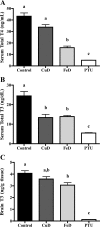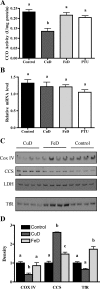Perinatal iron and copper deficiencies alter neonatal rat circulating and brain thyroid hormone concentrations
- PMID: 20573724
- PMCID: PMC2940517
- DOI: 10.1210/en.2010-0252
Perinatal iron and copper deficiencies alter neonatal rat circulating and brain thyroid hormone concentrations
Abstract
Copper (Cu), iron (Fe), and iodine/thyroid hormone (TH) deficiencies lead to similar defects in late brain development, suggesting that these micronutrient deficiencies share a common mechanism contributing to the observed derangements. Previous studies in rodents (postweanling and adult) and humans (adolescent and adult) indicate that Cu and Fe deficiencies affect the hypothalamic-pituitary-thyroid axis, leading to altered TH status. Importantly, however, relationships between Fe and Cu deficiencies and thyroidal status have not been assessed in the most vulnerable population, the developing fetus/neonate. We hypothesized that Cu and Fe deficiencies reduce circulating and brain TH levels during development, contributing to the defects in brain development associated with these deficiencies. To test this hypothesis, pregnant rat dams were rendered Cu deficient (CuD), FeD, or TH deficient from early gestation through weaning. Serum thyroxine (T(4)) and triiodothyronine (T(3)), and brain T(3) levels, were subsequently measured in postnatal d 12 (P12) pups. Cu deficiency reduced serum total T(3) by 48%, serum total T(4) by 21%, and whole-brain T(3) by 10% at P12. Fe deficiency reduced serum total T(3) by 43%, serum total T(4) by 67%, and whole-brain T(3) by 25% at P12. Brain mRNA analysis revealed that expression of several TH-responsive genes were altered in CuD or FeD neonates, suggesting that reduced TH concentrations were sensed by the FeD and CuD neonatal brain. These results indicate that at least some of the brain defects associated with neonatal Fe and Cu deficiencies are mediated through reductions in circulating and brain TH levels.
Figures




Similar articles
-
Fetal and neonatal iron deficiency exacerbates mild thyroid hormone insufficiency effects on male thyroid hormone levels and brain thyroid hormone-responsive gene expression.Endocrinology. 2014 Mar;155(3):1157-67. doi: 10.1210/en.2013-1571. Epub 2013 Dec 20. Endocrinology. 2014. PMID: 24424046 Free PMC article.
-
Fetal and neonatal iron deficiency reduces thyroid hormone-responsive gene mRNA levels in the neonatal rat hippocampus and cerebral cortex.Endocrinology. 2012 Nov;153(11):5668-80. doi: 10.1210/en.2012-1067. Epub 2012 Oct 9. Endocrinology. 2012. PMID: 23054056 Free PMC article.
-
Maternal iron supplementation attenuates the impact of perinatal copper deficiency but does not eliminate hypotriiodothyroninemia nor impaired sensorimotor development.J Nutr Biochem. 2011 Nov;22(11):1084-90. doi: 10.1016/j.jnutbio.2010.09.007. Epub 2011 Jan 15. J Nutr Biochem. 2011. PMID: 21239157 Free PMC article.
-
The effects of iodine deficiency on thyroid hormone deiodination.Thyroid. 2005 Aug;15(8):917-29. doi: 10.1089/thy.2005.15.917. Thyroid. 2005. PMID: 16131334 Review.
-
Prevalence of multiple micronutrient deficiencies amongst pregnant women in a rural area of Haryana.Indian J Pediatr. 2004 Nov;71(11):1007-14. doi: 10.1007/BF02828117. Indian J Pediatr. 2004. PMID: 15572822 Review.
Cited by
-
Thyroid Hormone Metabolites Quantified in Pup and Adult Rat Cerebellum, Cortex and Whole-Brain Samples Using an Automated Online SPE-LC-MS/MS Method.Metabolites. 2024 Jan 17;14(1):61. doi: 10.3390/metabo14010061. Metabolites. 2024. PMID: 38248864 Free PMC article.
-
Prenatal Choline Supplementation Diminishes Early-Life Iron Deficiency-Induced Reprogramming of Molecular Networks Associated with Behavioral Abnormalities in the Adult Rat Hippocampus.J Nutr. 2016 Mar;146(3):484-93. doi: 10.3945/jn.115.227561. Epub 2016 Feb 10. J Nutr. 2016. PMID: 26865644 Free PMC article.
-
Reducing uncertainties in quantitative adverse outcome pathways by analysis of thyroid hormone in the neonatal rat brain.Toxicol Sci. 2023 May 31;193(2):192-203. doi: 10.1093/toxsci/kfad040. Toxicol Sci. 2023. PMID: 37099719 Free PMC article.
-
Fetal and neonatal iron deficiency but not copper deficiency increases vascular complexity in the developing rat brain.Nutr Neurosci. 2015;18(8):365-75. doi: 10.1179/1476830515Y.0000000037. Epub 2015 Jul 15. Nutr Neurosci. 2015. PMID: 26177275 Free PMC article.
-
Fetal and neonatal iron deficiency exacerbates mild thyroid hormone insufficiency effects on male thyroid hormone levels and brain thyroid hormone-responsive gene expression.Endocrinology. 2014 Mar;155(3):1157-67. doi: 10.1210/en.2013-1571. Epub 2013 Dec 20. Endocrinology. 2014. PMID: 24424046 Free PMC article.
References
-
- Lomborg B 2009 Global crises, global solutions. 2nd ed. Cambridge, UK: Cambridge University Press
-
- de Benoist B, McLean E, Andersson M, Rogers L 2008 Iodine deficiency in 2007: global progress since 2003. Food Nutr Bull 29:195–202 - PubMed
-
- McLean E, Cogswell M, Egli I, Wojdyla D, de Benoist B 2009 Worldwide prevalence of anaemia, WHO vitamin and mineral nutrition information system, 1993–2005. Public Health Nutr 12:444–454 - PubMed
-
- UNICEF and The Micronutrient Initiative, Vitamin and mineral deficiency: a global progress report. United Nations Publications, Blue Ridge Summit, PA, 2004
-
- Hess SY, Zimmermann MB, Adou P, Torresani T, Hurrell RF 2002 Treatment of iron deficiency in goitrous children improves the efficacy of iodized salt in Cote d’Ivoire . Am J Clin Nutr 75:743–748 - PubMed
Publication types
MeSH terms
Substances
Grants and funding
LinkOut - more resources
Full Text Sources
Other Literature Sources

